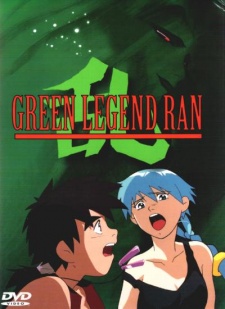
There's something to be said for Japanese post-apocalyptic worlds living in the shadow of a verdurous takeover. The image of broken remains of 21st century society—with grass and plants growing through every crack of pavement to reclaim what land is rightfully theirs—is something that captivates people across the globe, but anime sci-fi in particular has an abundance of worlds where those plants are more willing to take an active role in humanity's demise, in stories ranging from Origin: Spirits of the Past's tribal futurism to Miyazaki's environmental parables. On the flip side, a desert apocalypse, completely devoid of foliage or water altogether, is not at all unique to Japan, even if to my mind they perfected the story with Now and Then, Here and There. Merging the two is also not unheard of—Nausicaa of the Valley of the Wind exists after all—but it's certainly rare that a Nausicaa-esque tale of symbiosis comes along, and maybe even less common that the wilds and the wastelands come into conflict, as is the case in the Earth of Green Legend Ran.
As always, the desert is a place of lawlessness, even under an authoritarian rule. As compared to many stories though, in this world there exist sprawling slums, home to dozens more people than the ruined enclaves of Fist of the North Star and Mad Max. Green Legend Ran's slums are no less hopeless a place, with the few water wells scattered around the world slowly reaching the end of their seventy-plus year lifespan, and with a far-off ruling class called Rodo being as unsympathetic as one would expect from the overlords of a dying hellscape. Tradition dictates that our protagonist come from those slums of course, and going along with Now and Then, Here and There's model (or rather predating it by half a decade), Ran is a chipper fellow for someone whose life is bathed in destitute poverty. Maybe it's because he's good at stealing water when the Rodo aren't looking; cheerful optimism usually pairs well with pragmatism and a “screw the rich” attitude.
The players in the world are the Rodo, the resistance movement called the Hazzard, and a small group of ex-resistance fighters looking to establish peace. Ran gets pulled in by a number of factors, most of which are pure happenstance, one of which is an attractive silver-haired girl named Aira, and centrally his motivation for finding the man who shot his mother, the only parent he ever knew. He bounces between groups, being pulled along by his revenge quest and his desire to help Aira, who brings him into the Hazzard before being taken by the organization's head for a larger operation. Where he settles is with the ragtag group in the middle, because they represent absolute moral good in a world of pure depravity, which makes it easier for us as viewers to pick sides.
The fighting between these factions lessens in importance as the film goes on, which is unfortunate because they helped carry the plot and characters beyond the plot and characters. Animation fans will recognize Yoshinari Yoh, known for directing Little Witch Academia and just as known for his fantastic animation work throughout 90's, and Green Legend Ran is one of his earliest works, back when he wasn't given the job of drawing keyframes. The key animation was done in part Tanaka Tatsuyuki and Hashimoto Shinji, both of whom did key animation on Akira and later on The Hakkenden and Genius Party Beyond, all works with very distinctive designs that come through in the framing of Green Legend Ran from time to time.
Even with this cast, we only catch glimpses of truly inspired art. The early shots in the byzantine slums have a lot of great background design, and an urban firefight taken far too literally showcases a flowing burst of flames, flowing like liquid in the way that drives animation nerds nuts. Moving away from the city the art almost feels flattened, as if the backgrounds were made to have almost no depth, which forces a heavy artificial sense on the scenes. One more intriguing sequence has a bomb being contained in a triangular force field, playing with the dynamics of explosion in an imploding space, but the shot is only a few seconds long and is far more noteworthy for using the same instantly recognizable explosion soundbyte as the early Pokemon films. From there on out, there's not much to say.
I promised an encroaching forest as well. Behind the scenes of the Rodo lies a greater force than the petty human wars down in the city, and the natural silver hair that Aina has seems to signal her place in a much larger force of nature. We know it revolves around nature because she claims her home to be in the lone grassy field well above the town, and because of the mysterious voice calling from the water asking her to come back. We know that force to be malicious because it turns her one friend Ran into a mass of leaves in the wind right before her eyes (an illusion, mind you). Do we actually see the force? Not until close to the end, when the plot suddenly jumps to a battle between the world of the desert and the greenery it suppressed, and when it wraps up we're given a convenient way to solve the struggles of the working class. Maybe nature was just frustrated, and that's why it didn't figure out for itself how to resolve everything in one easy step like Aina and Ran did. Hard to say if the total closure is worth it though; I would've preferred to work under the illusion that we could get a sequel that goes back to focusing on the cool desert action.